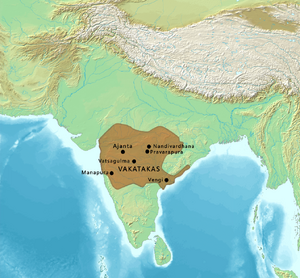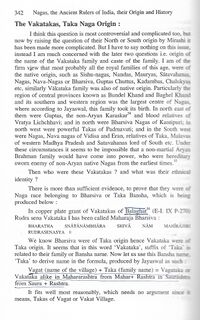Vakataka Dynasty
| Author:Laxman Burdak, IFS (R) |



Vakataka Dynasty (वाकाटक) was a royal Indian dynasty that originated from the Deccan in the mid-third century CE. They were the most important successors of the Satavahanas in the Deccan and contemporaneous with the Guptas in northern India.
Origin
- Vakata (वाकाट) or Vakatapura (वाकाटपुर) was name of Orchha princely state in Madhya Pradesh. It was place of origin of Vakatakas.[3]
Variants
- Vakataka dynasty
- Vakataka (वाकाटक)
- Vākāṭaka (वाकाटक)
- Vakatakas (वाकाटक)
- Vakataka Empire (वाकाटक)
- Vākāṭaka Empire (वाकाटक)
Extent
Their state is believed to have extended from the southern edges of Malwa and Gujarat in the north to the Tungabhadra River in the south as well as from the Arabian Sea in the western to the edges of Chhattisgarh in the east.
Vakatakas Inscriptions:Main Branch
Vakataka Inscriptions of Main Branch are from No.1-18 and of the Feudatories of the Main Branch are from No.19-22
Click the place name of Inscription below to know details:
Notes: 1. Places not identified have been marked ?
Jat clans
History
Source - Dr Naval Viyogi: Nagas – The Ancient Rulers of India, p.338
[p.338]: Earlier Vakatakas (250-510 AD) established their rule in Vindhya region. But later established authority over whole of Central India. From Vakataka inscriptions it is well established that a dynasty which took its name Vakataka came into existence about a century before Samudragupta's conquests. The first king of the dynasty was Vindhyashakti (250–270). Second king was Pravarasena I (270–330).
[p.339]: Pravarasena I was son of Vindhyashakti, who not only performed four Asvamedhas but also assumed the title of Samriit.48 He had a long reign, so much so that his eldest son Gautamiputra could not succeed him, but his grand-son Rudrasena I succeeded him. Gautamiputra himself was married to the daughter of the Bharsiva king Bhavanaga. The son of this union was Rudrasena I grand son of Pravarsena I and Bhavanaga. As, there was matriarchal system of heredity among the Nagas (Chapter V pp 102-03 and VI), hence Rudrasena I became the legal heir of throne of Bhavanaga in addition to throne of his own grand father Pravarsena I.49 Rudrasena I was succeeded by his son Prithivisena I. Rudrasena II son of Prithivisena I was married to Prabhavati Gupta daughter of Chandra Gupta II born of the Empress Kubera Naga. Prabhavati Gupta ruled as regent after the death of her husband Rudrasena II, as guardian to her minor son Yuvraj Divakarsena and subsequently to another son called Damodarsena or Pravarasena II.
It is obvious Vakataka dynasty took its root in Vindhya region and later extended its sways as far as Karnataka in South since Prithvisena subjugated the king of Kuntala a part of Karnataka and Kadamba kingdom.
Their capitals were at Purika, Chanak, Pravarpur and Padmapur and Branches at Nandivardhan and Vatsagulma.
48. Jayaswal K.P.,P.62 49. Jayaswal K.P.,P.63
Theories of Origin of Vakatakas
Source - Dr Naval Viyogi: Nagas – The Ancient Rulers of India, p.338
[p.339]: Whether the Vakatakas were Aryan Brahmans or Nagas has been a subject of great controversy among the historians. Among the scholars who identify Vakatakas as Brahmanas, Jayaswal K.P., is at the forefront. We, therefore produce his opinion.50. He writes, 'There is no doubt that Vakatakas were Brahmans. They performed Brihaspati-sava and also four Ashwamedha sacrifices... their Gotra was Vishnubraddha 51 (a branch of Bhardwaja) which is still prevalent among the Brahmanas of Maharashtra (A.S.R. Part IV PP-125 and 128 foot-note below and plate no 57). In Puranas they have been called Vindhyakas or royal family of Vindhyadesh. It is, therefore clear that they were original inhabitant of Vindhya Pradesh. The Vindhyakas or the Vakatakas used to live at the bank of river Kilkila or the country around it. This is a small river-near Panna, having a reputation for its unhealthy water. We are thus brought to very area, Ajaygarh-Panna where the earliest Vakatak inscriptions are found, that is the district of Ganj-Nachna. The Bhagwata Purana, is describing the Vidisa Nagas and Praviraka, calls the whole group The kila-kila kings. The location of dynasty in Bundelkhand is thus unanimous."
50. Jayaswal K.P., History of India, PP.66-67 51. According to an inscription of Varahdeva, who was a minister of Harisen, Vindhyashakti has been called Dvij E.I XXVI P.140

Source - Dr Naval Viyogi: Nagas – The Ancient Rulers of India, p.342
[p.342]: I am of the view that most probably like all the royal families, such as Shishunagas, Nandas, Mauryas, Satavahanas, Nagas, Navanagas, Bharashivas, Guptas, Chuttus, Kadambas, Chalukya etc., Vakatakas were also of native origin. Particularly the region of Central Provinces known as Bundel Khand and Baghel Khand and its southern and western region was the largest centre of Nagas, where according to KP Jayaswal, this family took its birth. In north-east oh them were Guptas, the non Aryan Karaskar (Vayu Purana, 78-23)....There is more than sufficient evidence, to prove that they were of the Naga Race, belonging to Bharashiva or Taka vansha, which is produced below.
In the copper plate grant of Vakatakas of Balaghat (KP Jayaswal, History of India, p.17) (E.I., IX, P.270) Rudrasena I of Vakataka dynasty has been called Maharaja Bharashiva: Bharatha Snātānāmbhāra Shiva Nām Maharaja Rudrasena.
We know that Bharashivas were of Taka Origin hence Vakatakas were of Taka Origin. It seems that in this word 'Vakataka', suffix of 'Taka' is related to theire family or Vansha name. Now let us use this Vansha name Taka to derive name in the formula, produced by KP Jayaswal as such:
Vagat (name of the village) + Taka (family name) = Vagataka or Vakataka (g→k) alike in Mahararashtra from Mahar + Rashtra or in Saurashtra from Saura + Rashtra.
It fits well most reasonably, which needs no argument since it means, Takas of Vagat or Vakat village.
Dr Naval Viyogi[9] writes....[p.344] Vakatakas used their original family name as suffix with the name of village. Vagat as indicated in the theory of learned scholar K.P. Jayaswal. In corroboration of this theory some examples of such place names related to Satavahanas, another branch of Taka family, are being produced below; Gautamiputra Srisatkarni in the inscription of Nasik cave (Epigraphia Indica Part VIII no 4 P-71) has called himself Venakatak Swami Gautami Putta Siri Sadakari (The lord of Venakatak Gauamiputta Siri Satakari). Dr. V.V. Mirashi (Sanshodhana Muktavali sery 1 PP 110-12) comments upon above adjective that progenitor of Gautamiputra were ruling there in Maharashtra in the beginning.65 Vena is a river Ven-Ganga near Nagpur.
There are also some more examples of places of like wise names falling in the same area such as; Bhojkata (k)66 Nagar-Katak67, Nandi Katak.68 Karahekatak, Dhankatak. It shows these Vakatakas were a branch of Takas, similar to Bharsiva Taka as proved earlier. It is interesting to note that although Samudra Gupta was daughter's son of Lichchhavis but he has been called only Lichchhavi Dauhitra and not Lichchhavi. But here Rudrasena I has been called Bharsiva Maharaja, who was daughter's son of Bharsiva who came on their throne owing to prevalence of matriarchal system in this family. It shows these Vakatakas were blood relatives of Bharsiva. That is why Rudrasena I has been called Bharsiva otherwise how these Bharsivas would have given their daughter as bride, as well as family throne to a Brahmanas who were their hereditary sworn enemies from the time of Mahabharat. (See chapter X P 261) and Arthsashtra.69
H.H. Wilson (V.P. VollI P-657) has furnished with another most valuable information favouring our theory "that there were thirteen sons of Vindhya Shakti and rest. The Bhagwata has a different statement identifying the sons of the Vindhya race with the Valhikas (Vahikas) and making them thirteen.
tesān trayodashasutā bhavitārscha vāhilkah - means "the Vahlikas will be their thirteen sons." According to Cunningham70 these Vahlikas or Vahikas were Taka Nagas. It evidently confirms our theory that these Vakatakas were definitely of Taka origin and perhaps related to the earlier branch of Vidisa Naga (See. P-330) or Sesha Naga since Vindhya Shakti has been mentioned as descendant of Bhutanandi in the Puranas.
In Bhagawar71 Purana there is a pedigree of early Nagas or Naga kings of Kilkila begins with Bhutanandi and ending with Praviraka or Pravarsena I son of Vindhya Shakti. It is as follows72 :
- kilkilāyan nirpatayo bhātananddoya vangirh
- sisunandischa tadbratā. yasonandih pravirakāh
65. See chapter XI PP 285-86 for details 66.Harivansha (Vishnu Parva 6-32) 67. Mirashi V.V.P. 46 68. (a) Mirashi V.V.P. 46, (b) JNSI Vol II (1940) P.94 69.Arthashastra of Kautilya, Sangha Vrata Adhikaran XI 70. Cunningham A, PP-125-26 71. Jayaswal K.P. PP-67 72.Jayaswal K.P. PP-69
[p.345]: Here king Praviraka or Pravarsena I Vakataka has been included in list of Nagas who were Kilkila kings. It means he was also a Kilkila Naga king. Kilkila is the name of river near Panna.
This gets confirmation from Vishnu Purana73 :
- Tesuchchha nneśukailkilā yavanā bhūpatayo bhavishyanti
- mūrdhābhiśikta steśāņ vindhya shaktih (16)
Meaning: Kilkila Yavanas will be the kings...The chief of whom will be Vindhya Shakti (the appellation of Yavana is for non-Aryan as amended later by the scholars). Here the king Vindhya Shakti has been called Kil-Kila Nag and non-Aryan both.
These Kilkila Nagas were earlier related to Vidisa known as Vidisa-Vrisha. This view is supported by another statement of K.P. Jayaswal. He writes,74 "The Puranas in detailing the rise of Vindhyashakti state that Vindhya Shakti arose from the Kilkila kings. Here it is clear that Puranas mean the Nagas who at that time were prominently connected with Kil-kila as their name changes from Vidisa- Vrisha to Kil-Kila Vrisha." eg Vayu (358-370)
- tachuchhanena cha kālena tatah kilakilāh-vrishah
- tatah k(a)ilakilebhyaś cha vindhya saktir bhavish yati
- (braharnanda verses j 78-179)
- vrishān vaidesakāmś chāpi bhavishyāmś chanibodhata"
It is obvious these Kila-Kila Nagas were earlier known as Vidisa Vrisha and later Kila-Kila Vrisha. It means they were earlier ruler of Vidisa. Hence it is proved finally that Vakatakas were offshoots of Vidisa Nagas.
73. V.P. (Wilson) Ch. XXIV Part II P-656 74.Jayaswal K.P. PP-69
List of Kings of Vakataka dynasty (250s–500s CE)

- Vindhyasakti (250–270)
- Pravarasena I (270–330)
The Pravarapura-Nandivardhana branch
- Rudrasena I (330–350)
- Prithvisena I (350–400)
- Rudrasena II (380–385)
- Prabhavatigupta (fem.), Regent (385–405)
- Divakarasena (405–420)
- Damodarasena (Pravarasena II) (420–450)
- Narendrasena (450–470)
- Prithvishena II (470–490)
The Vatsagulma branch
- Sarvasena (330–355)
- Vindhyasena (Vindhyashakti II) (355–400)
- Pravarasena II (400–410)
- Son name Unknown (410–450)
- Devasena (450–475)
- Harishena (475–500)
- Son name unknown (500-510)
References
- ↑ Schwartzberg, Joseph E. (1978). A Historical atlas of South Asia. Chicago: University of Chicago Press. p. 145, map XIV.1 (i). ISBN 0226742210.
- ↑ Dr Naval Viyogi: Nagas – The Ancient Rulers of India/General Index of Nagas, The Ancient Rulers of India, p.338
- ↑ Aitihasik Sthanavali by Vijayendra Kumar Mathur, p.838
- ↑ Dr Naval Viyogi: Nagas – The Ancient Rulers of India, p.342
- ↑ Tej Ram Sharma:Personal and geographical names in the Gupta inscriptions, pp. 16-17
- ↑ B.G. Gokhale, Samudragupta, Life and Times, pp. 25-26.
- ↑ Tej Ram Sharma:Personal and geographical names in the Gupta inscriptions, pp. 16-17
- ↑ B.G. Gokhale, Samudragupta, Life and Times, pp. 25-26.
- ↑ Dr Naval Viyogi: Nagas – The Ancient Rulers of India/General Index of Nagas, The Ancient Rulers of India,pp.344-345
- ↑ Dr Naval Viyogi: Nagas – The Ancient Rulers of India/General Index of Nagas, The Ancient Rulers of India, p.338

